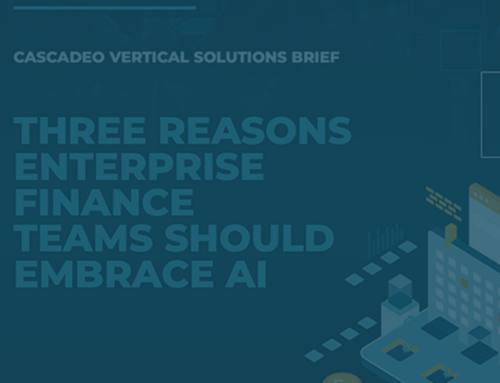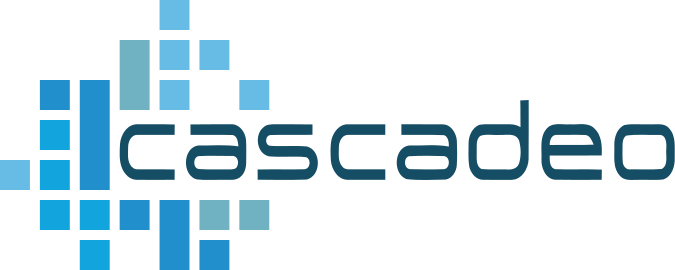
“So the key things there: you need to be cloud first. You need to be cloud native. You need to build cloud muscle memory and skill, either in-house or with a partner, because that is the foundation for all of the enterprise AI that’s to come.” —Jared Reimer, Cascadeo Founder and CTO
Hear Jared Reimer Discuss Generative AI, Serial Entrepreneurship, and his work on Silicon Valley on the Enterprise Radio Podcast
Listen here:
Transcript:
Introduction (female voice): Welcome to Enterprise Radio, the signature show of the Enterprise Podcast Network, featuring some of the most prominent business professionals in the world today. And now your host, Eric Dye.
Eric Dye: This is Eric Dye. And once again, welcome to Enterprise Radio, a part of VPN, the Enterprise Podcast Network. Today on the program, we’re joined by Jared Reimer, the co-founder and president of Cascadeo, a managed services and professional services company devoted to fostering customer innovation with a philosophy rooted in ethical engineering practices.
And Mr. Reimer, thanks for joining us here today.
Jared Reimer: Thank you for having us.
ED: Certainly is my pleasure. And thanks for your time. So for starters, tell us about Cascadeo and why you started the company.
JR: When I was an undergraduate, this is very early internet era, I ran one of the first dial up internet service companies in Seattle. And through that experience, we found that it was really hard to find companies that were oriented around meeting the needs of the client. Most of the professional services companies we found were beholden to these large equipment vendors or software vendors. And so the original idea was, somebody needs to represent the client, right?
Somebody needs to be the client’s advocate from a technology and engineering standpoint. We’ve also noticed, and this has been true forever, that to achieve scale in delivering professional services, a lot of the larger consultancies have to dumb problems down to something very simple, because the number of really highly skilled engineers that can do the leading edge stuff is, you know, relative to the market, is too small. We’ve always taken the opposite approach. We’ve always been willing to sacrifice scale for excellence. We like to work with leading edge technologies. We like to work with companies that are viewing cloud as strategic rather than as a cost center.
The other thing that, you know, initially I wanted to do, and this was quite a while ago—17 years ago—I was really into world travel, and I had met a couple from Microsoft who were traveling and working remotely. This was pre-LTE before the whole mobile revolution. They were using a satellite terminal and I thought, what a wonderful idea, you know, being able to see the world, explore, and work at the same time.
Most engineering, technical engineering work, can be done remotely. So I wanted to have it all. I wanted to do great work. I wanted to represent clients, and I wanted to be able to travel and not be tied to a desk. And 17 years later, we’re still at it.
ED: Well, you got to love that. And 17 years in business, that certainly says a lot right there. Good stuff and a great way to lead things off here today. Now, I understand you were the technical lead on the TV show Silicon Valley. Tell our listeners what that was like and what you did in that role. I’m sure they would love to hear.
JR: I was one of the senior technical advisors, so the producers of the show, it was an HBO show, were meticulous about making sure that every aspect of the show, especially the technical details, were perfect. They were very concerned that people would freeze frame the show and they would read the post it notes or the whiteboards, and they would find things that weren’t accurate or realistic and that they would, you know, use the opportunity to kind of. And so I was brought in specifically because of my background, having built an early dial up internet service provider, which involved building critical IT infrastructure in very odd places.
So we built modem banks in a church basement, a gas station, vacant office space. People’s homes. We built infrastructure in all sorts of weird places because back then we had to put the modems close to the customers. There wasn’t really a cost effective way of backhauling. Again, this was the early 90s, very beginning of the dial up era.
And so I had a special skill set and experience there. And if you recall in the show, they built their own data center in the garage of the house where the show is largely set. My role there was to help ensure absolute accuracy and perfection, along with some tongue-in-cheek, you know, references to things like Bitcoin mining, and mostly this involved collaborating with one of the producers and making sure that every single detail, the floor loading, the power, the heat, what it looks like, how people interface with it, the wiring, every little detail had to be believable and correct, but still with a nod towards, you know, comedy, right? It was fundamentally a comedy. All the actors were stand-up comics and, you know, you had to balance technical perfection with humor that people that are really technical would appreciate.
And it was one of the best experiences I ever had, honestly. It was fantastic. I got to spend time on the set. I got to go on location shooting. I got to meet the actors. Got to meet Mike Judge, who’s a personal hero of mine. He’s done a lot of brilliant work in the comedy genre over the years.
It was a wonderful experience. I can’t say enough good about it. Everybody that worked on that show was, you know, an A player as is usually the case with anything HBO does, and I think it was just a wonderful experience.
ED: I bet it was. Good stuff right there for sure.
Now, you’re also known for your knowledge about AI and what it means with respect to the cloud. Talk about this a little bit further, if you would.
JR: So as you know, there was a huge wave of cloud adoption, and that seems to have tapered off a little bit. I’m pretty certain that artificial intelligence is going to force the second big wave. The companies that did not go all in on cloud before now are going to have to do it because the complexity, the cost, the limited availability of the specialized hardware, and perhaps most of all, the lack of skilled engineering talent in this specialty area; all of that is going to force people to move to public cloud because there really isn’t another realistic way to do it.
Even if you have budget, even if you have, you know, existing data center, it’s just too hard. The hardware is too scarce. The talent is too scarce. So there’s going to be another big wave of cloud adoption. A lot of the companies that went first have a strategic advantage because their data is already there and they already have built up some muscle memory and skill with cloud computing.
And as you probably know, most of the generative AI platforms that are commercially available today are cloud-centric, offered by companies like AWS. So, honestly, I think this is going to be a do or die thing for most companies, other than the local barbershop or dentist. I think there’s a tremendous underappreciation for how broadly applicable large language models and generative AI are.
We’re at a weird turning point in history. You know, there was before, and there is after, and there’s no going back. The, the invention of large language models—CHAT GPT was the first, but by no means the last—and then the whole Cambrian explosion of generative AI, things that can make photorealistic images, poetry, music, art.
This is not just for technical professionals. It is for all white collar professionals in almost every specialty, especially work that can be done online. So knowledge work, creative work, things like photography, things like medical transcription, paralegal, contract attorney, and certainly software development, right?
One of the most important things about AI in its current form is that it makes people who would previously be either a junior developer or not able to write their own software suddenly capable of developing software almost at the skill level of a more experienced software engineer. So the number of people that suddenly can create software is going to increase by an order of magnitude and then another order of magnitude beyond that, as the technology keeps maturing and again, cloud is the underpinning for all of this, right?
We were invited to co-present with AWS at re:Invent, which is the largest cloud computing trade show last year, and one of the folks that we co-presented with did a demo. The demo went something like this: I have a bunch of photographs. Find me all the pictures that have cats in them. Find me all the details of those cats. How many cats? Are they big cats? Little cats? What color? What type of cats? And give me a structured list of the files that contain these cats and all of the attributes. And just by describing the outcome that he wanted, Code Whisperer, which is the AWS tool for, artificial intelligence generating software source code, right on stage, was able to build an application, run it in the cloud, point it at a collection of images and get exactly the output he wanted. And this was done in about five minutes flat. So this was one of those moments that people in the audience were gasping because no one had seen anything like this. The rate at which that kind of tooling and capability is maturing is unparalleled in the history of computer science.
So I think, you know, we’re at this weird inflection point where all of a sudden people are like, I’m not an artist, but I can create art now. I’m not a great photographer, but I can make images that look photorealistic. Anything you can dream up, even if it’s physically impossible, and they’re so good that companies like Google are having to invent ways to watermark them so that you can tell what’s real and what’s not, because even an expert no longer can tell the difference.
So it’s really a weird inflection point in history. But there’s no going back, right? All the talk of regulation or a six month pause, that is unfortunately not realistic. Even if we were to try to impose that on our own industry, it’s not going to happen. People aren’t going to do that, and certainly other governments aren’t going to do it. You’re just going to drive the work underground. The big question that remains is AGI, = Artificial General Intelligence, something more like a human that can learn any skill, even things that it’s never seen before. Before, I personally thought this was impossible. Now I’m a little less certain about that.
The current tools are specialized, right? They’re designed to do one thing and one thing very well. Predict the next series of words in a sequence in an essay or in a report. It’s not clear yet if we’re going to pass the true Turing test where AGI basically is as smart as a human, but the odds of that seem to have gone way up. So we will see.
ED: Some very interesting information shared, and I want to thank you for taking a moment to be with us here today. Certainly have enjoyed the details shared so far. We’re speaking with Jared Reimer, the co founder and president of Cascadeo, which is a managed services and professional services company devoted to fostering customer innovation with a philosophy rooted in ethical engineering practices.
He’s joined us here today. On Enterprise Radio, a part of VPN, the enterprise podcast network. Now, continuing on and again on AI, it is moving so fast. You recently wrote an article about the importance of staying ahead of the curve with respect to AI. If you don’t mind, share some of your thoughts on that as well.
JR: Yeah, so here’s the way I think of it: there’s already been a large earthquake in the ocean, and a tsunami has already formed, and it’s already racing towards the shore, and there are a lot of people playing on the beach that are completely unaware of what’s about to happen, and I think some of them have noticed that the tide is going out very quickly, and maybe some of them understand that that’s usually not a good indicator of what’s to come.
But the problem is that if you wait too long to run, it’s going to be too late. So this is one of those things where you have to get ahead of the curve. You have to ride the wave as it comes in, because if you don’t, for many professions, for many companies, it’s going to be a fatal error in judgment and recovering too late will be almost impossible.
So the key things there: you need to be cloud first. You need to be cloud native. You need to build cloud muscle memory and skill, either in-house or with a partner, because that is the foundation for all of the enterprise AI that’s to come. Amazon Bedrock is the platform that we use. It can run any number of different models for different purposes, and you can also build your own.
Building your own models, training your own models is very hard, but it’s getting easier. There are tools that are already out there to help this in the enterprise space, and what’s going to happen in very short order is that the software you already use, things like Microsoft Office, O365, and Google G suite, all of those will have AI built right in, and one day it will just magically appear. So for many people, they won’t have to do anything. This is just going to suddenly become part of their day. But the companies that are first to market and that get ahead of the curve and that ride the wave are going to have a massive strategic advantage. The companies that ignore it or fight it are going to oftentimes find themselves in a very, very disadvantaged place in the years ahead.
ED: Hey, good advice coming from you really do appreciate that. Now, like many C level tech executives, you’re also a serial entrepreneur. Give our audience a taste of what that entails from your perspective. I’m sure they would appreciate that as well.
JR: I think, first and foremost, don’t do this unless you really love a challenge in a marathon. It’s a very, very long, hard slog, not for the faint of heart, not for people that get easily discouraged. At one point I almost took a job at one of the giant tech companies. I’m glad I didn’t. I almost took a job at a super prominent Silicon Valley startup. I couldn’t because I had already started Cascadeo, even though at that point I wanted to. I’ve always enjoyed being on the bleeding edge of technology and working with whatever the latest thing is. And I think, you know, large companies tend to be late adopters. They tend not to be on the leading edge unless they’re in that business.
I think most people that find themselves repeatedly starting and building companies have an unusual tolerance for risk and maybe for suffering. It’s one of those things that are a cliche, right? Grit wins and that’s absolutely true. This is ultimately an endurance test and there’s a lot of pain along the way. Right? So I’ve never run an ultra marathon, but I can only imagine what mile 45 is like. I think building companies is sort of like that, right? One of the hardest things is that some of the smartest people, the most charismatic people, the most talented people, once in a while, they end up being the ones that are most likely to betray and to deceive. And that’s come as a great surprise to me. I always assumed that people that were really intelligent would win on merit, but some of them look for shortcuts. They look to seek personal gain at the expense of others. And that’s been a hard lesson that I’ve learned over and over again, that, you know, just because someone is intelligent or charismatic does not automatically mean that they’re a good person.
Another key lesson I’ve learned, you know, you don’t really know who your friends are when everything is going well. You find out very quickly when things are not going well. Like during the pandemic, we learned very quickly who our friends were because everyone, everything was in disarray and people that were true friends and allies, you know, banded together and supported each other. People that were in it to make a quick buck, you know, ran for the hills, or did sometimes terrible things to try to line their own pockets at the expense of others.
One of the other things that we’ve learned is the importance of partnering with larger players. You don’t want to become beholden to them, but if you play it right, and if you provide some value that they need, and can’t really get on their own, either because it doesn’t scale well, or it’s a specialty, these larger companies can be incredibly valuable partners and can do a lot to help you along the way. The key is not to become completely dependent upon them or beholden to them, right? And that’s a tricky thing to navigate. But I would say doing it without the support of a good partner network and an ecosystem, unless you’ve invented something brand new that’s truly never been seen before, that’s going to be really hard.
Even if you have invented something brand new and novel, you still probably will need a larger partner to help realize that potential and bring it to market. So know who your friends are. Pick your partners wisely, make that a two-way relationship, make sure you’re adding value to them so that they stay interested and invested.
Don’t do it if you’re easily discouraged or if you’re looking to make a quick buck, that’s the wrong reason to do it. It’s not the fast or easy path to stability or wealth creation. I think there’s a myth that, you know, everybody who starts a tech company somehow magically gets rich off of it. I think that’s the exception and not the rule.
I think like restaurants, most of them fail, but you only really hear about the success stories. So it’s one of those things that you’ve really got to be willing to stick it out, go through ups, downs, you know, market crashes, pandemics, bad actors within your organization, changes in the market, changes in technology, changes in the economy. There’s never a period of smooth sailing.
It’s always navigating from one storm to the next, and that can be exhausting. It can be really, really tiring. And there are days that you wish that you hadn’t ever done it. And there are days that it’s the highest high and the greatest thing ever. Clearly, it’s addictive. People keep doing it. There are a lot of serial entrepreneurs who, as soon as they sell one company, go out and start another one, but I think there are also a lot of people that try it once and quickly realize that it’s not for them. And again, those are the ones that you probably don’t hear about as much. So there’s probably, you know, selection bias in terms of the stories you hear, what you read about. What, you know, people that you hear on podcasts, you probably hear more from people that have had successful outcomes.
And honestly, there’s also a huge degree of luck involved with it. You could have the best product, the best technology, the best people, the best everything. And if your timing is off, or if your messaging is off, or if somebody else gets to market before you, or, you know, whatever the funding dries up, the economy tanks, some new virus comes out. I mean, there’s a million things that can go wrong that are completely out of your control. And sometimes, you know, even the people that should win don’t, and the people in companies that shouldn’t win do. There is a big element of luck and chance to it. It’s not quite gambling, maybe it’s more like poker where it’s a mix of skill and gambling, but there still is a lot that’s out of your hands, right?
There’s a lot that’s not under your control, and I think, for some people that lack of control and uncertainty and unpredictability would be really, really difficult to sustain. So, I wouldn’t do it unless you really, really know yourself and you know that you’re willing to stick it out even when things feel hopeless or impossible, even when people betray you, even when things aren’t going the way that you planned, it really is grit in the end that wins.
ED: Really do appreciate your thoughts on that. In fact, there’s a truckload of takeaways from your response to that question. I really do appreciate it. And especially from your perspective on being a serial entrepreneur and what it takes and what it entails. And we thank you for that advice and information before you go, where can listeners tap into Cascadeo and get further details and also a way to be in touch as well.
Jr: We’re at cascadeo.com. You can also find us on the AWS Partner Network Portal. We do a lot on LinkedIn, so if you’re a LinkedIn user, definitely look us up there. And I welcome the chance to talk with anybody directly if you have questions. You can contact me on LinkedIn. My LinkedIn username is Jared Reimer. And I always respond, so if you want to talk or have a question or want to discuss an idea, please reach out. LinkedIn is the best way to reach me.
ED: And of course, listeners, as always for your convenience, you can find this link within the show notes of this broadcast and other links mentioned.
Mr. Reimer, all the best. Thanks so much for spending a moment with us here today on Enterprise Radio.
JR: Absolutely. Thank you for having me again.
ED: We’ve been speaking with Mr. Jared Reimer, the co-founder and president of Cascadeo, a managed services and professional services company devoted to fostering customer innovation with a philosophy rooted in ethical engineering practices. And again, for all the details, visit Cascadeo.com. And this is Eric Dye, and you’ve been listening to Enterprise Radio, a part of VPN, the Enterprise Podcast Network. Tune into our live location as we are streaming live 24 7 around the world@epodcastnetwork.com slash live.
You can also find our live stream on iTunes radio, and tune in radio, as well as the TuneIn radio app for your listening convenience. And as always, we thank you for your support and for tuning in. Thanks for listening to enterprise radio. To subscribe to more of our programming, visit epodcastnetwork. com.
This is the E podcast network.




